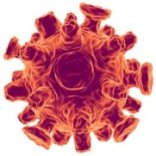New approach: a step closer to developing H5N1 vaccine

Manipulating a previously identified protein may be the key to developing an effective H5N1 influenza A virus vaccine.
The H5N1 virus has proven resistant to most antiviral drugs available for treatment, and therefore the need for an effective vaccine has been emphasised.
According to researchers from the University of Wisconsin-Madison and the University of Tokyo, the influenza A virus M2 protein consists of three structural domains, one of which is a 54-amino acid cytoplasmic tail domain. The researchers previously demonstrated that deleting the M2 cytoplasmic tail caused a growth defect in the H1N1 influenza virus, indicating that the M2 cytoplasmic tail plays a vital role in virus replication.
In the current study they created an M2 tail mutant H5N1 virus, vaccinated mice with it and challenged the mice with a lethal dose of the influenza virus. Results showed that the mice were protected from death, therefore suggesting that the virus could not replicate and could therefore be used as a vaccine.
“Here, we demonstrate that an M2 cytoplasmic tail deletion mutant protects mice from lethal challenge with a highly pathogenic H5N1 virus, suggesting the potential of M2 tail mutants as live attenuated vaccines against H5N1 influenza virus infection,” say the researchers.
Journal reference: T. Watanabe, S. Watanabe, J. Hyun Kim, M. Hatta, Y. Kawaoka. 2008. Novel approach to the development of effective H5N1 influenza A virus vaccines: use of M2 cytoplasmic tail mutants. Journal of Virology, 82. 5: 2486-2492.
Join 31,000+ subscribers
Subscribe to our newsletter to stay updated about all the need-to-know content in the poultry sector, three times a week. Beheer
Beheer








 WP Admin
WP Admin  Bewerk bericht
Bewerk bericht